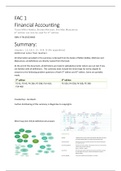Summary
Summary Financial accounting (FAC1)
- Course
- Institution
- Book
Summary chapters: 1,2,3,4,5, 12, 14 & 15 (No appendixes) Additional notes from teachers Mindmaps on chapter 1,2,3,4,12,14,15 List of defintions Answers to following problem questions 5th edition: P2-41; P3-45; P4-28A; P5-39B; P14-41B; P14-46B Answers to 6th edition: P3-35A; P4-35B; P4-36B; P5-39B
[Show more]




